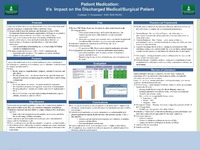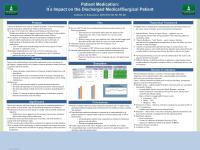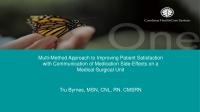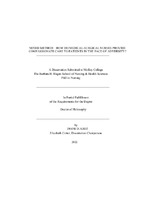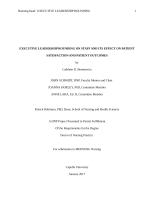| dc.description.abstract | <p>Session presented on Friday, July 24, 2015:</p>
<p>Acute care settings have an issue with readmission rates evidenced by the increasing frequency of their discharged patients returning as readmissions within a short time frame. A large contributor of these patients returning is due to their lack of medication understanding according to the Agency of Healthcare Research and Quality (2009). The issue of lack of, or limited, medication understanding has been on a steady incline as our population ages and with more patients being on a variety of medications upon discharge from the acute care setting. This widespread concern has caught the attention of healthcare providers, governmental agencies, as well as the nursing profession. The purpose of this project was to identify barriers our patients and their caregivers face upon transition to home from a medical/surgical unit, and to implement a new process which will increase the likelihood of decreasing their readmission potential. The goal was to provide a seamless transition of care, regardless of where they were being discharged to, while moving them to the next step on their healthcare journey. The healthcare team is tasked with ensuring both patients and their caregivers have the necessary information to ensure optimal health outcomes. Nurses work to promote health, prevent disease, and help patients and their loved ones cope with their healthcare needs. They are advocates and health educators for patients, families, and consumers (Mayo Clinic, 2014). Informed patients are more likely to comply with prescribed medication regimes and understand the risks related to medications and adverse events post discharge (Allaudeen, Vidyarthi, Maselli, & Auerback, 2011, p. 54). The literature review completed on medication understanding and its impact on the discharged medical surgical patient was found to be wide ranging. From the obvious, patient understanding, all the way through to follow up care and governmental agencies, patient education is extensive. For the purpose of this lit review, the focus was on patient education prior to and post discharge, government agencies and how they impact this issue, as well as the nursing profession and its impact on decreasing hospital readmissions. While utilizing a theoretical framework which included Patricia Benner, Virginia Henderson, and the Cognitive learning Theory, our unit based council evaluated our post discharge survey results from the National Research Corporation which were reflective of medication understanding, purpose, and side effects, and developed an educational model for patients and caregivers. The baseline metrics showed a combined score of 69.26% for medication understanding related to purpose and side effects for the last two quarters of FY14. With these results, an enhanced medication education was soon developed. Individualized laminated medication education cards were developed for each patient on the medical/surgical unit which included a picture of the medication, dose ordered, purpose, interactions, and side effects. These cards were left at the patient bedside for the duration of their stay and utilized with each medication moment. As new medications were ordered, they were added to the education module as well. Upon discharge, these cards were sent home with our patients which provided them with an accessible resource of all medications they were prescribed upon discharge. Not only were our patients being educated across the continuum of their stay, but were also provided a tangible tool that was familiar and individualized to their care for use at home. Upon completion of this project, at the end of FY15 Quarter 1, the combined score for the medical surgical unit had risen to 77.23% understanding of medication purpose and side effects. This far exceeded our goal of a 5% increase overall. These results clearly indicate early success of this tool, however, measurements will need to continue in order to sustain these results, which in turn will hopefully help in decreasing the overall hospital readmission rates. Health advocacy supports and promotes patient's health care rights as well as enhances community health and policy initiatives that focus on the availability, safety, and quality of care. As a nurse, it is our responsibility to get the information out to the public and to advocate for our patients and their loved ones. Professional nurses are ideally placed as information providers given the nature of their contact with patients, and they will need to ensure they work is within a philosophy of patient-centered care to ensure continuity of contact with their patients in order to meet the ongoing challenges of patient medication education. Medication education is clearly a domain in which the professional nurse can take the lead. It is our responsibility to ensure patients have what is needed for safe, effective transitions of care. This project is a clear example of increasing the patient's comfort with medication purpose and side effects, and the positive outcomes it can reap including a decrease in the hospital readmission rate.</p> | en |
